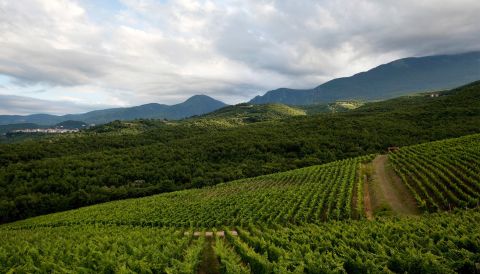If it hadn’t been for Kir Yianni, Naoussa as we know it might not exist.
Nor would this lovely wine, all tart cherries and bright acidity, forest floor and fine sandpaper tannins, a sort of Grecian Nebbiolo at less than $20 a bottle.
Let me explain. ‘Kir’ is short for ‘Kyrie’, or ‘Sir’ in Greek, and Kir Yianni is Yiannis Boutaris, who died on 9 November at the age of 82. He came from Greek winemaking royalty: his grandfather started the Boutari winery in the late 1800s (1879 officially, though Yiannis insisted it was 1858). That winery kept grape-growing alive for decades as Macedonia endured extended upheaval and unrest following the War of Independence in 1821, buying fruit from the grape-growers who managed to hold on to their land or those who took up farming when they found themselves relocated across northern Greece. Boutari began bottling wine branded with ‘Naoussa’ on the label in 1890; for a while, ‘Boutari’ was synonymous with ‘Naoussa’, the wine.
But when Yiannis joined his father in 1965, the region’s vineyards had largely disappeared. ‘Naoussa, by the end of the 1960s, was no more than 50 hectares of vines’, he told me when I met him at his winery in 1998. ‘Phylloxera, war, economics – it suffered.’ Yiannis focused on the vineyards, looking for ways to bring them back to health; his brother Constantinos soon joined him, focusing on finances. Together, they rebuilt the company into a juggernaut, with six wineries anchoring each of Greece’s most respected wine regions, a beer company (Mythos) and a listing on the Athens Stock Exchange. Naoussa flourished. ‘By the beginning of the 1980s, there were over 600 hectares [c 1,500 acres] planted’, he recalled. ‘In 1980, we formed the first interprofessional committee, focusing on how to bring up quality, not quantity – we had that down already.’ He was excited to see more players entering the market, more vineyards planted, and Naoussa reclaim its reputation for excellent wine.
But by 1994, Yiannis had grown disillusioned and broke off from the family company. He took with him only the pilot plot he’d started in 1970 in Yiannakohori, a town in the Naoussa appellation, and agreed to focus only on estate wines. That plot meant a lot to him, he explained, not just due to the work he’d put into it. ‘This vineyard pilot gave courage to others in the area’, he recalled. When he’d planted it, Boutari was the only grape buyer in the area. And until then, the grape-growers had been fruit-growers – meaning that they were in the business of selling fruit, and when the vines became less productive or the market forces turned toward peaches or other crops that brought in more money, the growers ripped out the vines and started over again. Yiannakohori was a beacon of promise planted on the 700-m (2,300-ft) pinnacle of Naoussa, a firm commitment to the future of Naoussa as a quality winegrowing region.
By 1998, when I first visited, he had his little vineyard divided into 32 plots, each undergoing studies on soil, rootstock, clones, exposures, trellising, as well as a host of grape varieties other than Xinomavro, which was virtually the only indigenous variety left in the region.
Yiannis named his winery Kir-Yianni and began selling wines commercially in 1997. He made waves with his flagship wine, the first-ever blend of Xinomavro with a French variety (Merlot), as well as Ramnista, his single-vineyard Naoussa.
Since 2004, Boutaris’s sons Stellios and Mihalis have run the business, while Yiannis looked for other ways to preserve the region’s community and culture, from starting a sanctuary for the local brown bear and wolf populations to becoming mayor of Thessaloniki, a position he held for two consecutive terms.
The winery, meanwhile, has continued to be a beacon for all of north-western Greece. That original flagship wine is now called The Fallen Oak, named for the tree that was a local landmark until a thunderstorm brought it down in 2017; while the blend is now half Merlot and Syrah, the rest Xinomavro, it remains resolutely Greek in its dark, brooding earthy flavours and smoky, tannic grip – a wine built for roast boar or a beefy stifado.
They’ve also been continuing the exploration their father had begun in the mid 1980s in Amyndeo, a high, cool plateau about two hours west of Naoussa (see the World Atlas of Wine map here). They now put out a head-spinning array of wines, both varietal and blended, featuring everything from Greek grapes such as Assyrtiko and Malagousia to imports like Sauvignon Blanc and Syrah.
Xinomavro, however, remains the backbone of the winery, and, by extension, the region. Despite its reputation for ferocious tannins and pale colour, its versatility is exceptional: witness Kir-Yianni’s range of sparkling and rosé wines. Vinified as a red wine, it is the Nebbiolo of Greece, producing wines that defy their translucent hues in their ferrous grip and deep, earthy flavours. Ramnista remains the apex to me – the 2019 is still in its infancy, likely not to hit its stride for another five or so years.
But now there’s the Naoussa Cuvée Villages to enjoy while waiting for Ramnista to come into itself. Made from the estate’s youngest vines along with purchased fruit, it’s a throwback to a time before single-vineyard wines, new French oak barriques and extended macerations. It’s a pan-Naoussa blend, pulled from an array of soils and exposures and clones. It’s picked when the fruit is still bright and the acidity frisky, and fermented in stainless steel to keep it that way. A year in oak (225- and 500-litre barrels, some new, mostly at least third use) takes Xinomavro’s rougher edges off, but not so much to render it soft. It’s spot-on Xinomavro, garnet-hued and tart in its red-cherry fruit, earthy and dark in ferrous flavours, with just enough tannins to rouse an appetite. With 14% alcohol and its firm structure, it’s a wine that will age well over the next 5–10 years, yet it’s delicious now, too – and priced for everyday drinking.
‘Wine is a cultural product’, Yiannis told me on that first visit. ‘We stick to Greek varieties because we have to find our way back to our past; without that, we can’t go to the future.’
With this Naoussa, Kir-Yianni has come full circle.
While this Naoussa doesn’t seem to have made it to the UK yet, Enotria & Coe and the online resource Epinoia carry Ramnista and many other cuvées. In the US, the wines are imported by Diamond Wine Importers and distributed by Skurnik Wines; the 2021 vintage is current but Sam recently found the 2020 while looking for a perfect pie pairing (see under under shepherd’s pie in Pie and wine). The wines are also available in Australia, Canada, Malta, the Netherlands, Switzerland and many other countries.
Want to know more about Greek wine? Our members have access to 70 articles by Greece expert and Master of Wine Julia Harding, and well over 3,500 Greek wine recommendations in our tasting notes database.


















